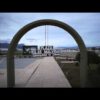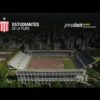Mafra National Palace
Mafra National Palace
Mafra National Palace Aerial View, Portugal Built in the 18th century by order of King João V (1689-1750) in fulfilment of a vow he made, to be blessed with an heir from his marriage to Maria Ana of Austria, or be cured of a serious illness, the Royal Convent and Palace of Mafra is the most important baroque monument in Portugal. All in limestone and marble from this region (Pêro Pinheiro and Sintra), the building covers an area of almost four hectares (37.790 m2), including 1.200 rooms, more than 4.700 doors and windows, 156 stairways and 29 inner yards and courtyards. Such magnificence was only possible due to the Brazilian gold that poured into the country, allowing the King to carry out his patronage of the arts and the strengthening of royal authority.For the Royal Convent of Mafra, the King ordered sculptures and paintings by great Italian and Portuguese masters and all the altar clothes, church vestments and religious gold and silverware were commissioned from France and Italy.During the reign of his son José I, an important School of Sculpture was founded here, under the Italian master Alessandro Giusti, responsible, for instance, for the Basilica's marble altarpieces.Mafra was King D. João VI’s favourite palace, who commissioned, at the end of the 18th century, mural paintings for several rooms and a new ensemble of six organs for the Basilica.The monument also contains one of the most important European libraries, with a precious collection of 36.000 volumes, a synthesis of 18th century encyclopaedic knowledge.Although the palace was never a permanent royal residence, it was frequently visited by royalty to hunt in the game reserve or to attend different religious festivities.It was from this palace that the last king of Portugal, Manuel II, left for exile on the 5th October 1910, following the proclamation of the Republic. Being a National Monument since 10-1-1907 and 16-6-1910, the Royal Palace opens as a museum in 1911 under the name of Palácio Nacional de Mafra. www.palaciomafra.pt


